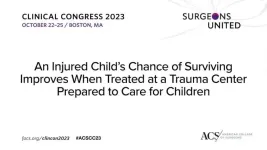Key Takeaways
Childhood trauma rates increased during the COVID-19 pandemic and were disproportionately higher for children in socioeconomically deprived areas.
In this vulnerable population, injuries were most often due to motor vehicle crashes, firearms, and non-accidental trauma.
The study adds to growing evidence of pandemic-related effects on health and reinforces the need for efforts to prevent pediatric trauma.
BOSTON (October 20, 2023): Injuries from gunshots and motor vehicle crashes increased among children and teenagers during the COVID-19 pandemic, especially those residing in socioeconomically disadvantaged neighborhoods, according to new research being presented at the American College of Surgeons (ACS) Clinical Congress 2023.
Pandemic-related stressors appear to have worsened an already severe problem, study authors report.
“The CDC [Centers for Disease Control and Prevention] recognizes traumatic injuries as the leading cause of mortality among children,” said study principal investigator Devon Pace, MD, MPH, a general surgery resident at Thomas Jefferson University in Philadelphia, Pennsylvania.
The study, conducted at Nemours Children’s Health, Wilmington, Delaware, also found that disadvantaged patients — those with adverse social determinants of health (SDOH) — had significantly worse trauma outcomes than less vulnerable patients.
SDOH are non-medical factors, such as socioeconomic status and crime, that influence health outcomes, according to the CDC. SDOH, including neighborhood environment, can worsen a child’s injury risk and postinjury outcomes.1
Within the context of SDOH, Dr. Pace said the researchers’ goal was “to see if we could identify how traumatic injuries in children are different before COVID and after COVID.”
About the study
The study included more than 4,000 trauma patients up to 18 years old who received treatment at Nemours Children’s Health from January 2018 to August 2022.
Patients were grouped by the date of their trauma visit. The pre-COVID group contained patients whose visit occurred before March 11, 2020, when the novel coronavirus outbreak was declared a pandemic.2 The other two groups were early in the COVID pandemic (March 11, 2020, through March 11, 2021), and late in the COVID pandemic (March 12, 2021, through August 31, 2022).
The research team measured patients’ SDOH risk using the area deprivation index (ADI). This index ranks U.S. census block groups, or neighborhoods, on multiple measures such as unemployment rates, housing stressors, and income levels, Dr. Pace said. A high ADI indicates high deprivation.
With statistical tests, the researchers evaluated associations between the ADI and pandemic timing and between the injury mechanism (cause) and trauma outcomes. Outcomes included intensive care unit (ICU) duration, time on a ventilator, length of hospital stay, and death.
Main findings
For all patients, study findings showed that during the pandemic, pediatric injuries happened most often from motor vehicle crashes and gunshots.
Motor vehicle–related injuries increased from 12.7% of all pediatric trauma cases before COVID-19 to 14.3% early COVID and 18.6% late COVID. The number of gunshot wounds increased from 1.2% pre-COVID to 2.6% early COVID and 2% late COVID.
When evaluating differences in injury patterns by ADI, the researchers found that the group living in high-deprivation neighborhoods had disproportionately more injuries than the low-deprivation group, Dr. Pace reported.
In the high-deprivation group, the rates of injuries sustained were as follows:
Motor vehicle crashes: 5% higher than in the low-deprivation group
Non-accidental trauma (child abuse): 3.4% higher
Gunshot wounds: 2.6% higher
A higher ADI was also associated with a longer ICU stay and more days on a ventilator, Dr. Pace noted. He attributed these worse outcomes to greater injury severity, such as motor vehicle and firearm injuries.
Child abuse increased in the high-deprivation group mainly early in the pandemic, he said.
However, some studies found that child abuse did not increase during the pandemic nationwide.3,4 Additionally, reporting of child abuse decreased as children’s contact with mandated reporters, including teachers and physicians, lessened.3
“Despite decreased reporting, our finding that child abuse injuries significantly increased suggests that these injuries were either more severe or more prevalent than we can even measure,” Dr. Pace said.
Alternatively, this injury pattern — and other patterns that Dr. Pace’s team reported — may vary by geographic region, he said. Most of their patients lived in Delaware, Pennsylvania, and New Jersey.
Messages for researchers and practitioners
Dr. Pace hopes their study will encourage researchers elsewhere to study the effects of the pandemic and SDOH on pediatric trauma.
“This is important,” he said. “We need to identify ways that we, as physicians, can prevent these injuries from occurring.”
He called for more preventive efforts by health practitioners, healthcare institutions, and policymakers. His suggestions included improved emergency preparedness plans, public health initiatives, and advocacy for policy changes that target reducing pediatric trauma and SDOH.
These findings add to growing evidence that pandemic-related stressors affected population-level health, according to the study authors.
“COVID caused a significant shift across the entire United States, socio-politically as well as economically,” Dr. Pace said. “This study starts to evaluate just the tip of the iceberg and identifies that these issues do exist.”
Study coauthors are Paulo Castro; Julia Gong, MD; Brandon George, PhD, MS; Russell McIntire, PhD, MPH; Charles N. Paidas, MD, FACS; Loren Berman, MD, FACS; Rosie Frasso, PhD, CPH; and Colin Plover, PhD, MSN, MPH.
The study authors have no disclosures.
Citation: Pace D, et al. Perfect storm? COVID-19, area deprivation, and their association with pediatric trauma, Scientific Forum, American College of Surgeons (ACS) Clinical Congress 2023.
_____________________
1 Trinidad S, Kotagal M. Social determinants of health as drivers of inequities in pediatric injury. Seminars in Pediatric Surgery. 2022;31(5):151221. DOI: 10.1016/j.sempedsurg.2022.151221
2 Cucinotta D, Vanelli M. WHO declares COVID-19 a pandemic. Acta Biomedica. 2020;91(1):157-160. DOI: 10.23750/abm.v91i1.9397
3 Chaiyachati BH, Wood JN, Carter C, et al. Emergency department child abuse evaluations during COVID-19: a multicenter study. Pediatrics. 2022;150(1):e2022056284. DOI: 10.1542/peds.2022-056284
4 Swedo E, Idaikkadar N, Leemis R, et al. Trends in U.S. emergency department visits related to suspected or confirmed child abuse and neglect among children and adolescents aged <18 years before and during the COVID-19 pandemic — United States, January 2019–September 2020. Morbidity and Mortality Weekly Report. December 11, 2020;69(49);1841-1847. DOI: 10.15585/mmwr.mm6949a1
# # #
About the American College of Surgeons
The American College of Surgeons is a scientific and educational organization of surgeons that was founded in 1913 to raise the standards of surgical practice and improve the quality of care for all surgical patients. The College is dedicated to the ethical and competent practice of surgery. Its achievements have significantly influenced the course of scientific surgery in America and have established it as an important advocate for all surgical patients. The College has approximately 90,000 members and is the largest organization of surgeons in the world. “FACS” designates that a surgeon is a Fellow of the American College of Surgeons.
END


